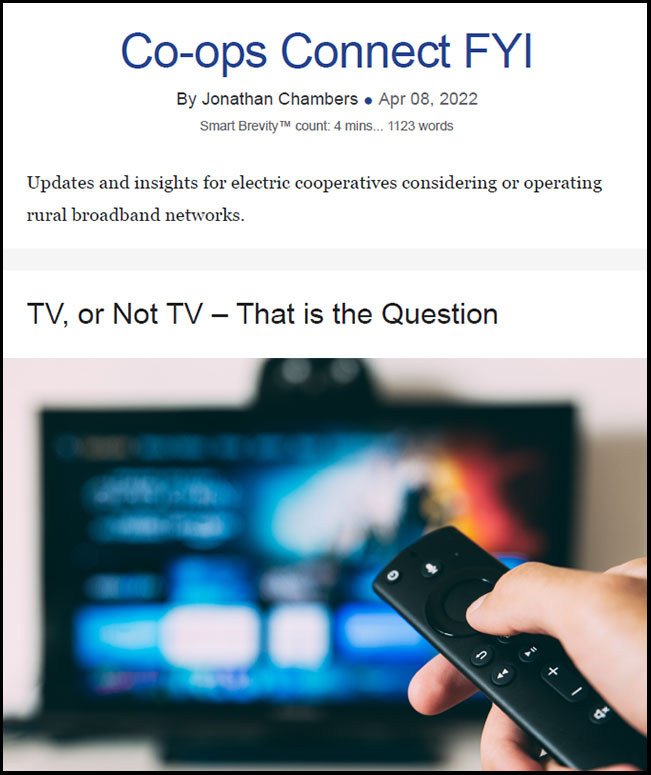TV, or Not TV – That is the Question
April 7, 2022
When I started in the cable industry (TCI, Cox and Comcast) in 1995, I worked for a business venture formed specifically to explore how to launch broadband.
Ancillary questions we asked at that time:
1. Do we offer landline voice service?
2. Do we enter the mobile voice market?
For telephone companies, the flip side of that question was:
Do they enter the video business?
(Does anyone remember the term “video dialtone”?)
Why it matters:
That same question is relevant today for electric co-ops entering the broadband business.
A Look Back
Three cornerstone pieces of legislation emerged in the 1990s with a common theme: Opening the telecommunications and video industries to competition.
1. 1992 Cable Act
2. Wireless sections of the 1993 Omnibus Budget Reconciliation Act
3. 1996 Telecommunications Act
The statutes were drafted by a group of creative and talented Congressional staff who had arrived at a common vision:
- Marketplace dynamics would produce better results than the court and regulatory regimes that followed the Modified Final Judgement — the break-up of AT&T.
- (I was Republican staff director of the Senate Commerce Committee, a witness to events. The vision was that of my colleagues.)
- At the time, the industry was comprised of:
- Seven Regional Bell Operating Companies (RBOCs)
- A long-distance industry (dominated by AT&T, MCI, and Sprint)
- Hundreds of small, rural telephone companies
- Several large cable companies formed by rolling up hundreds of home-grown cable operators (the cable companies often worked in concert on technology issues through CableLabs)
- Two cellular licensees for every geographic market (one license provided at no charge to the telephone companies, the other provided by lottery)
- A few “competitive” telecommunications companies focused on the commercial sector
- A nascent satellite television industry (DIRECTV and EchoStar, which became DISH)A nascent internet industry
A side note: I recall being visited at the time by electric utilities promoting broadband over power lines. I won’t name anyone who pursued that rabbit down that hole.
Why it matters: The past thirty years in this industry have been a case study of Schumpeter’s theory of creative destruction.
AT&T: A Case Study
Need an example? There are many, but I’ll pick just one.
Consider AT&T.
In general terms:
- The AT&T of the 1990s owned a long-distance company and Bell Labs as a consequence of the court-mandated break-up that separated the local, long-distance, R&D, and manufacturing components of the Bell system.
- Following the 1996 Act, AT&T attempted to enter the local telecommunications market by purchasing a CLEC from the cable companies (Teleport) and the cable franchises controlled by TCI.
- Failing spectacularly, AT&T sold the cable properties to Comcast and was acquired by SBC, which itself was a combination of Southwestern Bell, Ameritech, Bell South, and Pacific Bell (four of the seven RBOCs).
- Years later, AT&T, believing it needed to be in the video business, acquired DIRECTV because AT&T’s home-grown video business, U-Verse, was inadequate.
- AT&T spun off DIRECTV when it, too, became inadequate.
- The bottom line: DIRECTV’s long-term prospects may now rest on streaming services over broadband to compete with the video business of cable operators. Competing with cable was DIRECTV’s original reason for being in 1994.
Let’s return to my original question.
Should electric co-op broadband providers enter the video business?
For broadband providers, getting into the video business entails a choice:
1. Setting up and operating a video headend
(Co-op examples: Co-Mo Connect, OzarksGo, Northeast Rural Services)
2. Using a third party’s video headend
(Co-op examples: GoSEMO Fiber, Pemiscot Dunklin Fiber, WAVE Rural Connect)
3. Using a cloud-based headend
(Co-op examples: OEC Fiber, Cumberland Connect)
Go deeper:
From a financial standpoint, offering video packages to broadband subscribers is a low-margin, competitive business.The cost of programming swallows up margins.
You have no leverage negotiating with broadcasters and other content providers.
Broadcasters raise their rates every year or threaten to withhold their content.
The bottom line:
When broadcasters raise their rates, you either eat the cost, or increase your prices and your customers will blame you.
Why it matters:
Your customers really care about television in a way they don’t care about electricity or broadband.
So why provide video services at all?
Apart from the small profit margin, for 25 years, cable operators havesuccessfully sold a bundle of broadband and video, or broadband, video and voice (the so-called triple play).
Some customers have grown accustomed to the bundle and some customers are reluctant to break the bundle.
The video business has changed more in the last few years than it has since the 1980s.
Consumer choice in pay TV for years consisted of a single cable provider and satellite providers.
The change in recent years has come about as video streaming services started competing directly with cable and satellite services.
I am referring not to video service that supplements live television like Netflix, HBO, or AppleTV, but multichannel video streaming platforms, such as YouTubeTV (owned by Google), HuluTV (owned by Disney), and DIRECTV Stream (spun off by AT&T).
The bottom line:
The new landscape provides consumers a choice for the first time: of providers, user interfaces, and programming packages.
Consumer choice is messy and confusing and a wonderful breakthrough for video.
Broadband has shaken up the production and consumption of video content.
An Open QuestionI’ve always been in the dumb pipe business. I’m content to allow others to create content without influence or interference or walled gardens. That includes video content.
My instinct as an operator of a broadband business is simply to provide the best connection between creators and consumers.
However: There is one role for co-op broadband providers in TV that may be beneficial.
Co-op broadband providers can make it easier for co-op members to set up their streaming TV service while the broadband service is being installed.
Let’s call it the “Fourth Alternative”:
1. As a co-op, you could certainly educate members about streaming services.
2. You could work with a streaming service provider, such as YouTubeTV, HuluTV, or DIRECTV Stream.
3. Or you could become a reseller of one of the streaming services.
4. It’s clear that when you have an installer in the home connecting a member to your internet service, it is a simple matter to assist the member with video at the same time.
The big picture:
Conexon has successfully combined the purchasing power of scores of electric co-ops to improve the pricing of materials and electronics for each individual broadband co-op.
Can we take the same collective approach with video streaming services?
Let me know if you’re interested.

